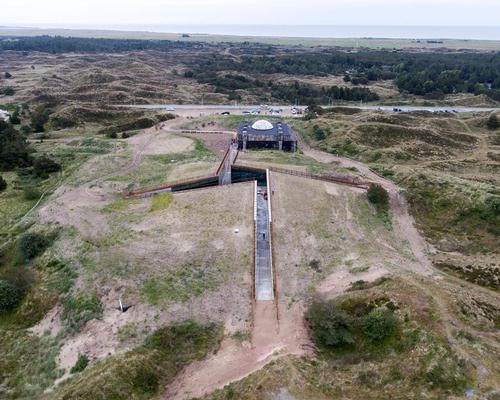14 Jul 2017
BIG expand Danish WWII bunker and create museum camouflaged among the dunes
BY Kim Megson

Bjarke Ingels Group’s (BIG) transformation of a former German WWII bunker into a cultural complex camouflaged among the protected dunes of Blåvand, western Denmark, has opened to the public.
Conceived as “a sanctuary in the sand”, the 82,000sq m (882,600sq ft) museum, called Tirpitz, has been successfully completed three years after construction began.
Upon arrival, visitors first see the bunker, which was one of hundreds of coastal defences and fortifications built by the German army during the war as a defence against an invasion of Nazi-occupied Europe.
Beyond the bunker, the new museum emerges as a series of intersecting, precise cuts in the shoreland landscape – designed to contrast with the heavy volume of the wartime structure.
The complex is divided into four main underground galleries, each with their own rectangular-shaped space. These can be viewed and accessed from a central courtyard on ground level, with 6m tall glass panels allowing natural light to flood into the interior spaces. A tunnel links the galleries with the back of the bunker.
“The architecture of the Tirpitz is the antithesis to the WWII bunker,” said BIG founder Bjarke Ingels. “The heavy hermetic object is countered by the inviting lightness and openness of the new museum.
“The galleries are integrated into the dunes like an open oasis in the sand – a sharp contrast to the Nazi fortress’ concrete monolith. The surrounding heath-lined pathways cut into the dunes from all sides descending to meet in a central clearing, bringing daylight and air into the heart of the complex. The bunker remains the only landmark of a not so distant dark heritage that upon close inspection marks the entrance to a new cultural meeting place.”
The building consists of four main materials and elements – concrete, steel, glass and wood – which are found in the existing structures and natural landscape of the area. The walls of the exhibition rooms are made of concrete cast onsite, supporting the landscape and carrying the roof decks – engineered by Swiss Lüchinger+Meyer – that cantilever out 36m (118ft). The main interior materials are wood and hot rolled steel, which is applied to all the interior walls.
Dutch scenographers Tinker Imagineers created the museum’s exhibitions, which showcase permanent and temporary themed experiences dedicated to Blåvand’s history and “treasure trove of hidden stories.”
‘Army of Concrete’ tells the human stories in the shadow of Hitler's enormous European defence project, the Atlantic Wall; ‘Gold of the West Coast’ is Western Europe's most comprehensive exhibition of amber; and ‘West Coast Stories’ tells 100,000 years of west coast history and is turned into a nighttime 4D theatre twice an hour. In the dark of the bunker, visitors can play with light and activate shadow plays that reveal how the bunker should have functioned.
“Tirpitz is a unique opportunity to combine nature and culture in a spectacular fashion,” said Erik Bär, founding partner, Tinker imagineers. “A visit to the museum is not a visit to an exhibition gallery, but a scenic journey through time and space of West Jutland. The idea is that the whole place itself comes to life following the rhythms of nature.”
The museum was financed by the municipality of Varde, alongside the A.P. Møller and Chastine Mc-Kinney Møller Foundation, the Nordea Foundation and the Augustinus Foundation. It is expected to attract around 100,000 visitors annually.
It is the latest in a series of major cultural projects for BIG. In 2013, the studio completed the Danish National Maritime Museum, in which crucial historic elements are integrated in an innovative concept of submersed galleries. They are also working on the LEGO House in Billund, Denmark; the MECA Cultural Center in Bordeaux, France; and the Smithsonian Institution Master Plan in Washington D.C, US.
Close Window